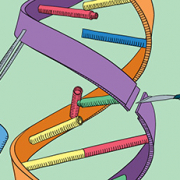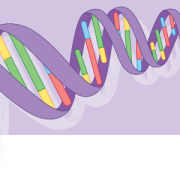The omics revolution
Genomics is changing medicine, providing insight into diagnosis of cancer and rare disease – but what could other ‘omics’ sciences reveal?
The main aim of the 100,000 Genomes Project is to sequence whole genomes of patients with rare diseases and cancer. An add-on to the project is to collect high quality samples for future ‘omics’ research, recognising that these have the potential to add depth to the clinical interpretation aspect of the 100KGP project. So what are ’omics‘, and what is their potential? Fiona Macdonald explores.
Omics explained
Omics refers to the collective technologies used to characterise and quantify pools of biological molecules and to explore their roles, relationships and actions in the cells of a living creature. The ‘omics’ suffix has been added to describe the use of these technologies to examine proteins (proteomics), the chemical processes involving metabolites (metabolomics) and RNA molecules (transcriptomics) in cells, as well as genomes.
Tracking genomic activity: the transcriptome
The transcriptome is the complete set of RNAs being actively produced from the genome at a specific time. Transcriptomics identifies those genes which are active in an individual tissue, or even a single cell, and is also referred to as expression profiling. RNA is the intermediary between the genomic DNA code and the protein products of those genes, and so transcriptomics can integrate information from genomic, proteomic and metabolomic studies.
Microarray technology has been extensively used to study the transcriptome, but can only be used to detect known RNA sequences, and so cannot uncover new RNA sequences. However, commercial array-based expression profiling tests such as Oncotype DX, which detect expression of a panel of key genes associated with breast cancer, have NICE approval in the UK to guide treatment decisions.
Developments in RNA-based sequencing technologies have led to the expansion of transcriptomics to allow both the presence and amount of different RNA molecules to be determined. One early example of the clinical impact of these tests is again in the cancer field: Columbia University’s transcriptome test, which is being used alongside whole exome DNA sequencing test in paediatric oncology patients.
From genome to proteome
Proteomics is the study of the overall composition, structure, function and interaction of the proteins directing the activities of each cell, which are studied using both mass spectrometry and gel-based methods. The advantage of proteomics over genomics to identify novel diagnostic and therapeutic targets is both in the scale and nature of the targets. We have approximately 20,000 genes in the genome of a cell, but because genes may encode multiple protein variants, each of which can undergo additional modifications, there are even more unique protein targets. Therefore proteomic studies can take us further towards precision medicine.
Proteomic studies in Alzheimer’s disease have identified proteins not previously associated with the condition, providing new insights into the molecular basis of disease as well as potential new diagnostic and prognostic disease markers. In oncology, the proteomic-based GPS cancer test from NantOmics provides clinicians with information on multiple clinically relevant protein targets for therapeutic intervention. In Nature this month1, a study from the NCI’s Clinical Proteomics Tumour Analysis Consortium has combined genomic and proteomic data from breast cancers to look at the effect of tumour mutations and identify possible therapeutic targets.
Making the most of the metabolome
The metabolomics market was estimated at $6.8 billion in 2015 and is still growing. Metabolomics is defined as the comprehensive analysis of all metabolites and low molecular weight compounds (estimated to be over 19,000 in number) in a biological specimen. They are analysed using nuclear magnetic resonance imaging (NMR) and mass spectroscopy techniques. Measuring a small number of metabolites is not a new concept; conditions such as inborn errors of metabolism are diagnosed by testing for a few specific metabolites, but current metabolomics testing can profile hundreds to thousands of metabolites. Diseases can be characterised and diagnosed based on their overall metabolomic profile, which can also lead to the discovery of new biomarkers both for diagnosis and therapeutic monitoring, and the development of novel therapeutic targets.
Applications of metabolomics are already in the diagnostic arena. For example, cancers alter cellular metabolism, creating novel targets that can be exploited for diagnosis and therapy. A urine-based test to detect metabolites unique to pre-cancerous colorectal polyps is now licensed for use in the US, with a sensitivity described as being significantly higher than existing faecal-based assays for early detection. A recent development in the rare disease field is a mass spectroscopy approach to diagnosis of the cholesterol storage disorder Niemann-Pick Type C from newborn bloodspot samples, allowing rapid diagnosis and treatment to minimise disease processes before the onset of neurological symptoms.
Given the potential for these technologies to advance our knowledge and provide new clinical tools, it’s not surprising that Genomics England wants to maximise the long-term research potential of the 100,000 Genomes Project by collecting samples for future use. These include serum and plasma samples for proteomics and metabolomics, RNA for transcriptomics, and tumour tissue samples for RNA expression profiles. Different DNA samples are also being collected: cell-free serum for circulating tumour DNA analysis, and DNA for epigenetic analysis. The omics pilot is still only at the planning stage, but will hopefully in time provide exciting additional insights into diagnosis of rare diseases and cancer that will lead to further developments in personalised medicine.
1. Mertins P et al. Proteogenomics connects somatic mutations to signalling in breast cancer. Nature (2016) doi:10.1038/nature18003
Fiona Macdonald is a consultant clinical scientist based primarily in the West Midlands Regional Genetics Laboratory, and is a fellow of the Royal College of Pathologists. She is an author on more than 80 papers and has also written a variety of book chapters as well as co-authoring two books on the molecular basis of cancer.
–









